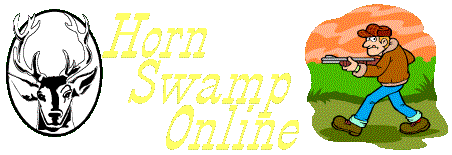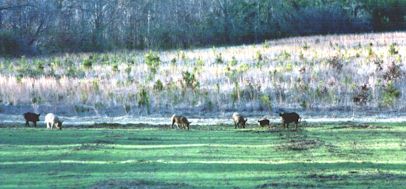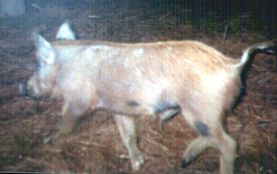
Wild Hogs of the Swamp

Wild hogs rooting up a greenfield!
The big news in the area these days is the incredible population explosion of wild hogs. Migrating up the river, wild hogs first appeared in the Swamp around 1991. Since their arrival on the scene they have grown in number each year. They have done much damage in their brief history here. Somewhat as a result of their unwanted existence in the Swamp, they have become one of the most popular species of animal that is hunted. In the first eight years since they were first seen, over 225 were been shot or trapped.As of 2006 the population has stabilized and possibly declined from its peak in the late 1990's. A few deer seasons have now passed with only limited sightings. Though we continue to harvest them at every opportunity, our count has declined in recent years as the data below shows. However, the hogs remain in the Swamp and evidence can be seen from one side of the property to the other. They are very nocturnal and, therefore, trapping is the best way to eliminate some from the area. We are now seeing signs that the coyotes are eating some of the young pigs, evidenced by the hog hair seen in coyote droppings.
A few milestones...
09/10/1992: First hog is caught using dogs.
12/11/1994: 20th hog killed in Swamp.
01/20/1995: 40th hog kill recorded.
02/15/1997: 70th hog kill recorded.
09/26/1998: 167th hog taken from Swamp.
01/31/2000: 219th hog taken.
02/04/2001: 227th hog taken.
01/02/2003: 251st hog taken.
The Feral Hog:Feral hogs are increasing in number all across Alabama. Feral hogs should not be confused as another game animal that will benefit hunters and landowners. They are nuisance and no hog should ever be released into virgin territory. Their eating habits are destructive. Being omnivores they eat most anything in their path, plant or animal. They will even eat young fawns, ground nesting birds, eggs, etc. They eat acorns and other seed crops. Their rooting can destroy ground nesting sites and lead to erosion.
The greatest competition between deer and hogs is for fall mast and fruit crops. Deer will often scatter at the sight of a hog, especially in areas where hogs have not inhabited for a long time. Deer don't like big, noisy animals and that description fits a hog perfectly.
Studies show that over 80% of the hog population must be killed each year for the population to remain steady. They are capable of producing several litters of up to eight young each year. Once hogs are established in an area they are impossible to eradicate. Yet, it is important to strike at the population at every chance.
Hogs are extremely noisy creatures. One can often hear a hog squeal from a quarter of a mile away. Grunts can be heard from a closer proximity. Hogs are often so intent on their feeding that hunters can approach very close, much closer than you could ever approach feeding deer without being detected. Hogs like thick areas to hide and feed, especially briar thickets and young pine plantations.
Hogs can often be found with ease during many times of year, but much easier during the colder months. They feed on acorns during the fall and then turn to roots, grubs, and such during the winter. In late winter when the food gets scarce for all animals, hogs will move much more. Overall they are known to move more at night than the day.
Hogs have an incredible since of smell. Studies have shown that a hog can locate a potato in two feet of water from 100 yards away. It is estimated that their sence of smell is 10 times as sensitive as a deer's. Though their sight and hearing is well below average, their nose evens the score.
About hog hunting:
Hunting specifically for hogs has become more and more popular in the Swamp as the population grows. Many of the hogs we harvest are taken while deer hunting. On private land there is no closed season on hogs and no bag limit. The only restriction is for daylight hours only. Hogs often appear in food plots, hardwood bottoms, or pine plantations in range of deer hunters on their stands. Some hogs are killed by bowhunters.
Continuous scouting reveals where the hogs are feeding. Their deep rooting leaves no doubt as to where their feeding is taking place. Hogs make so much noise that they often give away their location and that can lead to an easy ambush for an armed hunter. When feeding and especially breeding, which by the way takes place very often, the hogs can be heard grunting and squealing. Their loud behavior is likely their most significant weakness.
Shot placement on hogs is especially important. With a bow, the archer must shoot the hog behind the shoulder and drive the arrow between the shoulder blades for a quick, clean kill. A hog shot broadside and behind the shoulder blades (a perfect shot on a deer) often will not down a hog. A shoulder shot is not recommended when using a rifle. A head shot should be made with a rifle. A shoulder shot, though will likely mortally wound a hog, will leave little blood to follow and little chance of collecting your kill. Unlike thin-skinned deer that most hunters are accustomed to, hogs have a thick hide that does not bleed well. Dropping the hog on the spot is important. Chasing after a wounded hog is especially dangerous and has resulted in many stitches for some unsuspecting hunters.
We also trap hogs. (see our hog traps page) Baited with corn, the traps are very effective in capturing up to 5 hogs at a time. However, wildlife baiting regulations in Alabama make it difficult to trap hogs during deer season. Alabama does not permit baiting of deer or turkeys and no corn can be present on property that is being hunted, not even in hog traps! However, you might check with your local game warden for his interpretation of this.
We use movable cage type traps and also permanent pen style traps. Examples can be seen on our hog trapping page, including helpful dimensions for building your own trap.
Again, hogs can be very dangerous! Their sharp tusks do not have to be more than an inch long to inflict serious harm to anything that challenges them. Dogs used to chase hogs are often cut and occasionally killed by large and vicious hogs. Extreme care must be taken when on the ground in the near vicinity of a group of hogs.
Wild hogs in a greenfield.
Public hog hunting land in Alabama:
Our Hunt Alabama link contains updated information about hog hunting opportunities in Alabama. Join the fight against these unwanted animals and have some fun in the process!

